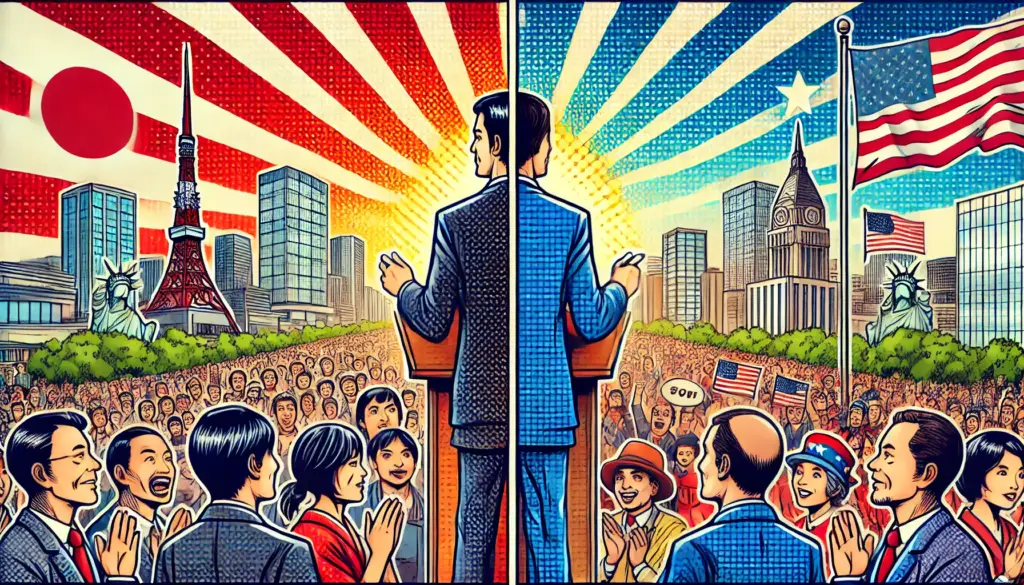
🇯🇵🇺🇸 A Tale of Two Populists: Sohei Kamiya and JD Vance
In recent years, both Japan and the United States have seen the rise of new, outsider politicians who position themselves as defenders of forgotten citizens and national tradition. While these figures emerge from vastly different cultural and political systems, Japan’s Sohei Kamiya and America’s JD Vance share a surprising number of similarities—from humble beginnings and ideological shifts, to fierce opposition to elites and globalism.
While Kamiya is not widely referred to as a “Japanese JD Vance,” the comparison offers a fascinating lens into how parallel populist energies manifest across two of the world’s largest democracies.
🎓 From Left-Leaning Youths to Right-Wing Crusaders
Both men began their journeys with unexpected ideological foundations:
- Sohei Kamiya, born in rural Fukui, Japan, was once sympathetic to left-leaning views during his youth. After studying abroad and traveling through 18 countries, he returned home disillusioned with Japan’s education system and society. Exposure to traditional moral philosophy (especially Moralogy) and conservative literature dramatically shifted his worldview.
- JD Vance, raised in a broken working-class household in Ohio, described his upbringing in his memoir Hillbilly Elegy. Although educated in elite institutions like Yale Law School, his personal experiences led him to reject liberal orthodoxy and embrace nationalism, traditionalism, and skepticism toward elite narratives.
👉 Both underwent personal ideological transformations shaped by life experience, not inherited political dogma.
👨👩👧👦 Not Born Into Privilege
Neither Kamiya nor Vance comes from wealth or political lineage.
- Kamiya grew up in a modest household where his parents ran a local supermarket. He worked as a public high school teacher and later helped manage the family business before entering politics without backing from major parties or dynasties.
- Vance was raised by his grandparents in a household troubled by addiction and instability. He joined the U.S. Marine Corps, served in Iraq, and later built a career in law and venture capital before running for office.
Both narratives reject the polished resumes of career politicians and resonate with working- and middle-class voters who see themselves reflected in these upstarts.
🌾 The Voice of Forgotten Regions
What binds these two even more tightly is their regional base of support.
- Kamiya’s Sanseito party finds strong backing in rural and suburban areas, especially among voters disillusioned with Tokyo-centric policymaking.
- Vance, similarly, draws power from America’s industrial Midwest—the very regions often overlooked by coastal elites.
📢 Both portray themselves as champions of the neglected majority, representing hometown values rather than metropolitan consensus.
🌍 United in Their Fight Against Globalism
Both leaders are vocally anti-globalist:
- Kamiya questions the legitimacy of Japan’s postwar constitution, criticizes foreign influence in education and media, and emphasizes national sovereignty and cultural identity. He views global finance and multinational institutions with deep suspicion.
- Vance opposes free trade agreements, mass immigration, and U.S. military entanglements abroad. His America First policies align with a vision of economic nationalism and cultural revival.
✋ In both cases, globalism is seen not as progress, but as betrayal—a mechanism through which local traditions are eroded and working families are left behind.
🛐 Different Faiths, Shared Morality
Though their religious orientations differ, both leaders root their politics in moral renewal.
- Kamiya draws from Japan’s spiritual traditions, especially Shinto-based values and moral education. While not overtly religious, he emphasizes spiritual independence and traditional family roles.
- Vance is a devout Catholic, advocating for policies rooted in Christian morality such as opposition to abortion and support for nuclear families.
💡 Regardless of theology, both frame their missions as a cultural and ethical awakening, not just political reform.
📱 Winning Hearts Outside the Mainstream
Neither Kamiya nor Vance depended on mainstream media to build their platforms.
- Kamiya built his following via YouTube, blogging, and direct appeals to citizens through town halls and grassroots movements.
- Vance rose to fame through a best-selling book and alternative media circuits, not legacy TV or newspapers.
Their success illustrates a broader shift: citizens are tuning out of traditional media and tuning in to voices they feel speak directly to them.
💬 Final Thoughts: A Shared Political Archetype
Sohei Kamiya and JD Vance don’t know each other, and they rarely appear in international headlines together. Yet their stories echo across the Pacific.
Both men:
✅ Grew up outside elite structures
✅ Began on the political left before moving right
✅ Draw support from overlooked regions
✅ Oppose globalism and elite control
✅ Emphasize morality, family, and national pride
🧭 In an age where voters crave authenticity, rootedness, and courage to challenge the status quo, these two men represent a growing archetype in global politics: the provincial conservative populist.
Whether in Japan or the U.S., their rise signals a deeper cultural shift—one that no capital city can ignore.



















































